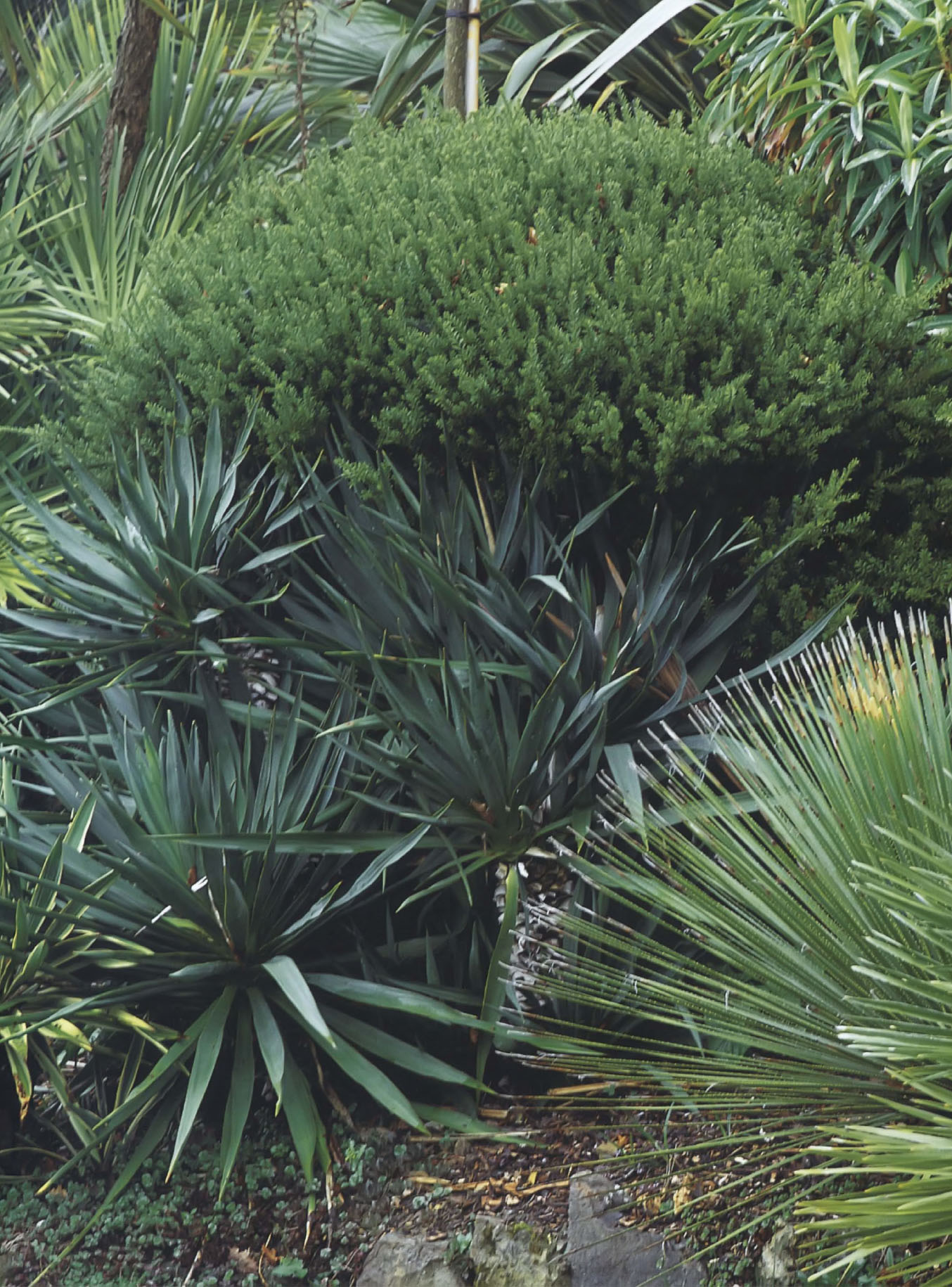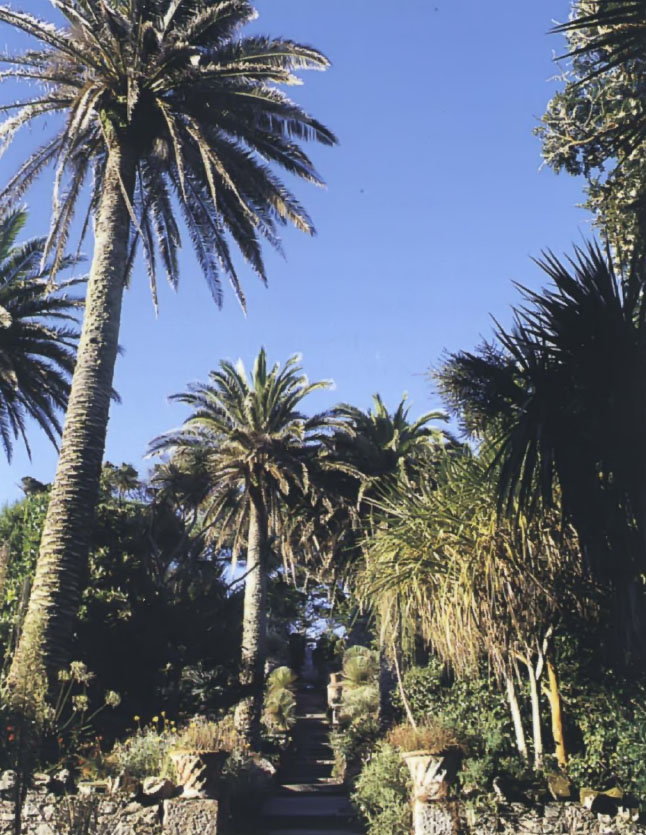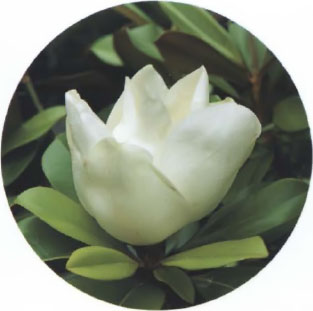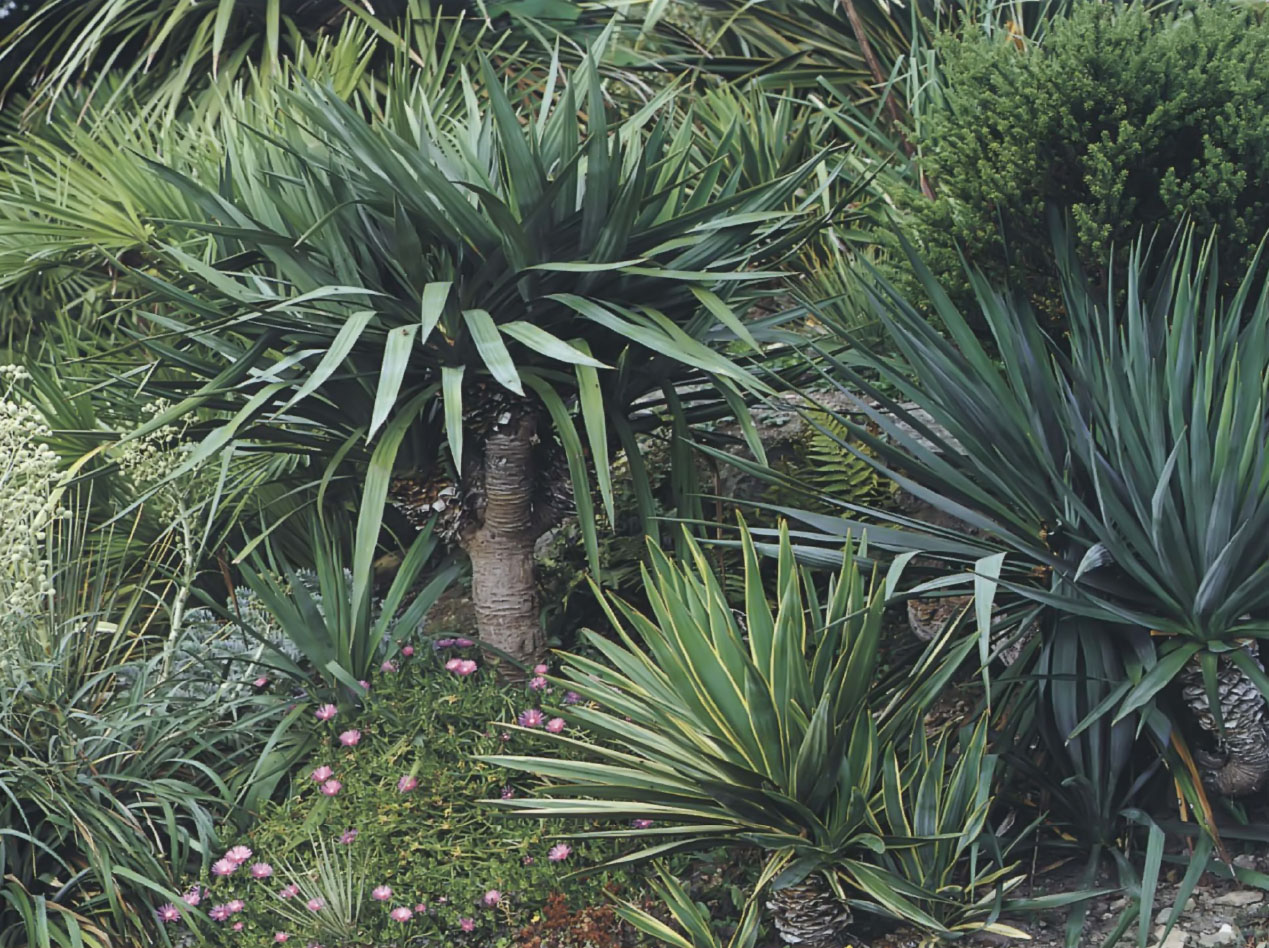
Полная версия
Architectural Plants

ABOVE
Sparmannia africana is a fine plant for filling a corner of a large conservatory.
Conservatory plants
By checking the cultivation requirements of the various plants featured in this book and by reading the section on how to grow plants in pots (see pages 20–27), you can soon assemble a list of suitable plants for growing under glass. If the heating, ventilation and irrigation topics have been addressed, you will have more than a sporting chance of attaining the dream of a conservatory filled with lush, healthy, exotic plants.
The single most useful and beneficial thing that you can do in the heat of the summer is to move all your plants outside for the hottest months. They will appreciate not only the fresh air, but also the rain, which helps to clean any dust from the leaves.
Pests & diseases under glass
The unnatural conditions of being under glass, the hostile environment of fluctuating temperatures and the problems of growing plants in containers mean that pests and diseases are virtually guaranteed at some time or other. Once bugs are happily ensconced, they can breed with alarming rapidity. Some insects, such as whitefly, can produce another generation mature enough for laying its own eggs within three days.
Check all plants at least once a week, looking not just for insects, but also for any signs of fungal infections, moulds, rotting or any other maladies. Dealing with any problems at the very first sign saves all sorts of trouble for the future. There’s no point ignoring it and hoping it will go away – it won’t. The more an infestation takes hold, the harder it is to deal with.
The chapter on pests and diseases (see pages 334–347) gives more comprehensive information, and there is also a Rogues’ Gallery (see pages 340–347) to help you identify exactly which horrors to look out for.
Professional maintenance contracts
The difficulties of looking after plants grown in conservatories are well known in the horticultural trade. As a result, teams of marvellous people are always available to help gardeners keep everything looking healthy. They will visit your home regularly to check that all is well in the conservatory. They will water, feed and clean plants whenever necessary and dispense valuable advice at the same time. They take all the hard work out of looking after plants, leaving you just to enjoy the results.

ABOVE
Tibouchina urvilleana adores lots of heat and humidity.

Architectural plants in the garden
Gardening with architectural plants is no different from any other type of gardening, but I can appreciate that planting a garden with unfamiliar plants might be a bit daunting. The usual rules still apply, although I prefer to think of them as tips and helpful advice.
Walking into an architectural plants nursery for the first time can be overwhelming. When faced with plants that look so big, bold and different, it’s easy to assume that all those on sale are fully grown, mature specimens. Although such a nursery is not for the timid, closer inspection will reveal that this type of gardening is not just about large plants.
You will also find on display a massive selection of smaller, easily affordable plants lurking throughout and underneath all the greenery. There is usually plenty of stock readily available that doesn’t require a second mortgage. So, if you’re new to this type of gardening and are bowled over by the choice of plants on offer, where do you start?
Garden design
There is a lot of pretentious nonsense bandied about garden design. If someone thinks that a selection of plants looks good together, who’s to say that they are wrong? As long as the gardener or client is happy with the result, that should be all that matters. But, many of us are happier with a few guidelines to assist, so here are just a few.
Choose plants that suit your type of garden and learn as much as you can about what keeps them happy.
It is important to choose plants that are right for your garden and to learn as much as possible about the growing conditions that would suit them best. (This is discussed in detail on page 16 and also in the individual plant entries.) Also, try to learn a bit about their eventual size – there is little point planting small plants near the back of the border where they will be obscured from view in a couple of years. This is, of course, all common sense that applies to any type of gardening, not just gardening with architectural plants.
Another common-sense strategy when planting – but one that I completely ignore – is to allow space around each plant so that it can spread without being crowded by its neighbours after a few seasons. Common sense it may be but, to impatient people like myself, this is something far too boring even to contemplate. I like to see a wonderful lush garden within two years, not ten. If plants start to crowd together, then I either get out the shears and do some serious pruning or, better still, thin out the number of plants and transplant the spare ones somewhere else.
Using the same plants throughout the garden to carry on a theme, rather than just having one of each type of plant, is something I am very keen on. It is much more pleasing and organized to look at. If one of your favourite plants happens to be, for instance, a Yucca gloriosa, start by planting one in a position where it is easily seen, and then plant several more along the length of the border or garden at various intervals. This effect gives the impression that a deliberate planting plan has been thought about, rather than appearing as a random hotchpotch. It is a commonly held misapprehension that using the same plant more than once is boring and shows a lack of imagination. Plant one of each only if you are an avid collector or the curator of a botanic garden.

ABOVE
A specialist nursery will contain plants of all sizes to suit every budget.

ABOVE
Multiple planting of the same type of plant (here, Blechnum spicant) gives much more dramatic results.
Still on the subject of multiple planting, small plants such as some ferns, grasses or groundcover plants are much more noticeable and give a more dramatic effect when planted in large sweeping groups of all the same type.
And, when using architectural plants as screening, groups and rows of bamboos or trees do the job very well but, again, the effect is less messy if all the same types of bamboo or tree are selected. Not only is the result more visually appealing, but the growth rates will be the same, keeping the screening more uniform as it matures.
Using the same types of climbing plants across a fence or over a pergola also looks tidier, but I usually fail miserably in persuading clients to go for this option. Gardeners expect climbers to work hard, providing screening, flowers, fragrance and a bit of colour for the whole growing season. Indeed, choosing from the range of climbing plants in this book, this is certainly possible to achieve but, from an aesthetic point of view, lots of the same is easier on the eye. And if they all intermingle with each other, it doesn’t matter at all.
Larger plants such as trees, palms and bamboos look perfectly okay when planted as single specimens and as the main focal feature of the garden, but they can also be effective in small groups. Palm trees look particularly good planted together in groves, with all the plants of slightly different heights. Grouped in this way, you can almost kid yourself that they grew there naturally.
With architectural plants, the emphasis is on the foliage, not the flowers, so it can be great fun experimenting with all the different shapes, textures and shades of green to make different effects. For example, in a shady corner, the large glossy leaves of a Fatsia japonica, the fat crinkly foliage of Eriobotrya japonica, the blue-green spiky leaves of Yucca x floribunda and the emerald-green, soft foliage of Hebe parviflora angustifolia look lovely all grouped together.
In a sunnier position, the combination of the small, bright green foliage of a bamboo such as Phyllostachys aurea, the spiky sword-shaped leaves of Phormium tenax, the large, shiny leaves of Acanthus mollis all underplanted with the dense groundcover of Rosmarinus repens makes an interesting mix.

ABOVE
Pleioblastus variegatus makes a pretty contrast to other larger bamboos.

ABOVE
Strongly shaped architectural plants do not need flowers or colour to make them noticeable.
Generally, because of the lack of too many gaudy flowers, architectural plants can be mixed and matched in almost limitless combinations. At this point, it is time to throw in a few words about variegated plants. With architectural plants, the colour green obviously dominates, and with all the hundreds of shades of green, little else is really needed. Even the absence of a constant array of flowers is not much of a loss. But, just occasionally, introducing a contrasting plant can add that bit of extra interest. If a coloured-leaved plant such as Rhamnus alaternus variegata, Yucca gloriosa variegata or Phormium tenax variegata is planted among masses of green, the effect can be quite stunning. However, if too many coloured-leaved plants are added, the whole contrasting effect can be diluted to the point of being lost. So, think green, and you can’t go far wrong.

ABOVE
Beautifully shaped palms are striking enough to grab anyone’s attention.

ABOVE
This photo shows a perfect choice of plants for a layered effect in a small garden.
After introducing architectural plants to a garden, other ordinary garden plants can start to look dull, which usually leads to the buying and planting of more and more shapely specimens. If you plan to turn the whole garden over to architectural plants but you are on a fairly tight budget that allows only a gradual transformation, spend your cash on planting the garden in sections. Completely finishing one small area can make a much more rewarding difference than spreading out your new plants in just ones and twos around the garden.
If you prefer a more traditional garden that just needs a little oomph, architectural plants can fit in surprisingly well with existing planting. A shapely, evergreen architectural tree will not seem out of place as a focal feature in any style of garden. A couple of palms or a large Yucca can enliven the dullest of herbaceous borders without appearing at all alien. An olive tree can look wonderful in any sun-baked courtyard. And bamboos or large grasses planted around ponds look totally acceptable, even if the rest of the garden is turned over to lawn and vegetables.
If space is a bit limited, it is surprising how many large plants can fit into one small area if the varying heights are taken into account. The photo shown opposite below is a brilliant illustration of professional design and imagination (alas, not mine!). A canopy of tall Eucalyptus glaucescens provides the first layer. Underneath these, a few Cordyline australis nestle to provide the next layer and also provide shade and shelter for tree ferns (Dicksonia antarctica), which are tall enough to leave room for ground-level plants such as Astelia. It’s inspirational stuff indeed, and there’s no reason why amateur gardeners can’t create something reasonably similar.
Beautiful as architectural plants are by day, they still have some hidden talents up their sleeves. It is easy to forget about the garden once the sun sets, but some of these plants are so sculptural and shapely that they can even look fantastic at night with some carefully positioned up-lighting to accentuate their silhouettes. The plants with the strongest shapes such as palms, Yucca and Agave work best with spotlights on them.
One last comment to add about planning your own garden is not to be too strict in your choice of plants. After reading up on plants you like the look of, it’s usual to write down a few favourites and compile a list of those that you’d really like. The longer the list, the less chance there is of obtaining them all during one shopping trip. However good your preferred nursery is, to expect it to stock every size of every plant all year round is being unrealistic. It is better to make a very short list of essentials, then visit the nursery and spend time looking around to see what looks good at the time. Make your final selection from what you see on the day. Otherwise you could spend a long time tracking down every single plant on a long wish-list.

ABOVE
Pseudopanax crassifolius is an essential ingredient for a New Zealand-style garden.
Themed planting
Most architectural plants enthusiasts start with just one or two specimens at a time and gradually build up a wider selection later on. It is not unusual for the entire garden to be filled with these beautiful plants eventually. Some gardeners take things one step further and theme their garden in one particular foreign style. This is often done straight after a particularly enjoyable holiday when you are wishing you were still there. Theming the garden allows the mind to be transported back to whichever part of the world you recently visited.
Settlers new to a particular country sometimes like to be reminded of their homeland, and they plant their gardens accordingly: New Zealanders and Australians living away from home seem to have a special passion for doing this. As the choice of architectural plants is wide, it is easy to develop gardens that are reminiscent of one particular country or region. The provenance of the plants doesn’t have to be strictly correct as long as the look of it suits what you are trying to create. For example, a Mediterranean-style garden could be created using plants such as Italian Cypress (Cupressus sempervirens), Umbrella Pines (Pinus pinea), Magnolia grandiflora, olives and palms, together with Trachelospermum jasminoides and Pittosporum tobira to add the familiar scent found in Tuscany or the south of France.
Some might prefer a Japanese look, with the emphasis on Black Bamboo (Phyllostachys nigra), together with trees such as Podocarpus macrophyllus and Phillyrea latifolia, and maybe some Japanese topiary as well, such as Ilex crenata and formally clipped Buxus sempervirens or curved mounds of Hebe rakaiensis.
Jungly gardens can be very dramatic using palms, bamboos, Banana Plants (Musa basjoo) and anything else with large leaves such as the Foxglove Tree (Paulownia tomentosa) and Rice Paper Plant (Tetrapanax papyrifera). Loud splashes of colour can be introduced with any of the Canna or Ginger Lilies (Hedychium), and all types of large-leaved ferns could be used for the underplanting.
Australian-type gardens would have masses of all types of Eucalyptus, Acacia dealbata, Acacia pravissima, Callistemon subulatus and Solanum laciniatum, probably planted densely around a summer house with a corrugated iron roof and a shady verandah.
New Zealand gardens can easily be created in cooler areas that have a high rainfall. With a mix of Cordyline australis, Dicksonia squarrosa, Phormium, Astelia and the fabulously weird and wonderful Pseudopanax crassifolius, pulling back the curtains every morning and gazing out on plants such as these could make you forget which country you actually live in.
My favourite group of plants is the spiky and succulent one, and any choice of these can look fab together. To look out of the window and see a scene that could easily be from the Sonoran Desert in Arizona always gives me a real buzz. A mix of Agave, Yucca and Dasylirion can be used to good effect, although postmen, meter readers and visitors to the house don’t seem to share my enthusiasm for these plants – they’ve probably been on the receiving end of the sharp thorns once too often.

ABOVE
Leafy tree canopies underplanted with palms give a jungly feel.

ABOVE
Loud and vibrant flowers remind us of trips to the Caribbean.

ABOVE
Rows of formal Cupressus have an air of the Mediterranean about them.

ABOVE
The rich scent of Magnolia grandiflora flowers fills the air in Italianate gardens.

ABOVE
Planting schemes like this remind me of the Sonoran Desert in Arizona, but they can be created in even the chilliest garden.
There are enough plants in this book to create gardens with Chilean and South African themes too. Depending on how vivid your imagination is, you could replicate the planting of just about any country in the world. There are also plenty of plants that can be used to make much more traditional gardens, as well as those where the emphasis is on fragrance. Believe it or not, it is possible to create unusual, bright, flowery gardens – there are just about enough exotic blooms among these plants to satisfy the floral needs of gardeners, despite the emphasis being on their foliage. There are also lots of plants here that have excellent salt resistance, which makes them very practical for seaside gardens.
Last of all, even bog gardens can get a look in with a selection of moisture-loving specimens such as Gunnera manicata, Acorus gramineus variegata, Zantedeschia aethiopica ‘Crowborough’ and Arundo donax.
I can’t think of any garden anywhere that wouldn’t benefit from at least a small selection of architectural plants.
Garden designers
If you really can’t bear the thought of choosing your own plants and would prefer someone else to create a beautiful garden for you, then it’s worth considering bringing in a professional.
There are lots of garden designers out there, and although many of them are talented and dedicated people, some of them are not quite so marvellous. So, how do you choose one?
There is nothing to beat a verbal recommendation from a chum or neighbour who has recently had their garden revamped. And it’s usually a fairly safe bet to employ someone who’s been in the business for a long time. He or she will have the benefit of years of experience and, hopefully, will still retain a certain amount of enthusiasm for the task.
Don’t just accept quotes from one designer; it pays to shop around. It is also reasonable to ask to see their portfolio of recent commissions. If their photos are beautifully presented in a well-cared for album, this bodes well. If their portfolio consists of a few faded pictures stuffed into a tatty old envelope, then their attention to detail probably won’t amount to much.
Within reason, try not to be too influenced by the cost quoted. To dismiss a quote purely because it’s expensive can definitely be the wrong thing to do. You might miss out on the best, tidiest, nicest and most professional teams of chaps or ladies in existence. Sometimes a very cheap quote might not include various hidden extras that will be tacked on at the end of the job. In other words, the gardening world is no different from anything else when it comes to employing someone’s service.
Finally, just because someone is a designer, don’t assume they are a gardener. Some designers never leave their office desk and will present you with a garden plan only. The planting and hard graft might still have to be done by you.
New gardens & borders
Sometimes the opportunity arises to create a completely new section of garden. If a reasonably large area is being considered for this type of planting, its preparation should be given some careful thought. Architectural plants need the same kind of preparation as most other types of plant, but it’s useful to offer a couple of tips on the subject here.
Fashionable advice is often given about the use of some kind of membrane cover, such as Mypex. This is placed over all of the soil in a large sheet and is used to suppress weeds and slow down water evaporation. Please, please, I beg of you, don’t use this ghastly stuff. It’s truly awful and, although it does keep the weeds from growing, the disadvantages far outweigh any benefits. Although useful for large commercial areas, it has no place in a private garden. Once in situ it becomes impossible to condition the soil in any way. Digging can’t be done – this won’t hurt for a couple of years but, long-term, it isn’t a good thing, as the soil will gradually become more compacted and stagnant. Feeding, except with foliar food, isn’t possible. Worms can’t work the soil, as they cannot pass back and forth through the material. Adding any new plants is a bore because the material has to be uncovered and cut before a planting hole can be dug. And, lastly, it’s hideous to look at. Even when top-dressed with a mulch of pea shingle or bark chippings, the weather and local wildlife will soon shift this around, exposing areas of it to public view. Well, I think I’ve probably made my views on it more than clear, so enough said.

ABOVE
A careful balance of shape and colour can be used to create a pleasing mix of architectural plants.
When a new border has been dug over and levelled, it’s a useful opportunity to be able to feed the whole area in one go prior to any planting. Numerous references throughout the book are made to using copious quantities of well-rottted manure. This is excellent for providing all sorts of nutrients for practically all types of architectural plant. But, make sure it is well rotted and has reached the stage where it is dryish and crumbly. If it is runny and smells bad enough to make your eyes water, then don’t use it. When it is this fresh, it needs nitrogen to help it to rot down further. So, instead of adding much-needed nitrogen to the soil, it is actually taking it away. Also, very fresh manure can scorch delicate foliage and roots. If well-rotted manure is difficult to obtain, buy sacks of 6X from the local garden centre. It works just as well and is easy and pleasant to use. It also stinks out the entire neighbourhood for about a week but, what the hell … Blood, fish and bone also gets talked about a lot in these pages. It is bought as a powdered mix and sprinkled over the surface of the soil. It smells awful, but the horrible pong will soon fade. If you keep a pet dog, this powder will have to be forked in lightly otherwise the greedy mutt will feast on it.


